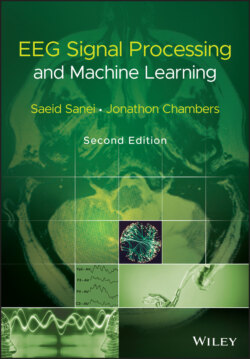Читать книгу EEG Signal Processing and Machine Learning - Saeid Sanei - Страница 36
2.9.4 External Effects
ОглавлениеEEG signal patterns may significantly change when using drugs for the treatment and suppression of various mental and CNS abnormalities. Variation in the EEG patterns may also rise by just looking at the TV screen or listening to music without any attention. However, among the external effects the most significant ones are the pharmacological and drug effects. Therefore, it is important to know the effects of these drugs on the changes of EEG waveforms due to chronic overdosage, and the patterns of overt intoxication [69].
The effect of administration of drugs for anaesthesia on EEGs is of interest to clinicians. The related studies attempt to find the correlation between the EEG changes and the stages of anaesthesia. It has been shown that in the initial stage of anaesthesia a fast frontal activity appears. In deep anaesthesia this activity become slower with higher amplitude. In the last stage, a burst‐suppression pattern indicates the involvement of brainstem functions, including respiration and finally the EEG activity ceases [69]. In the cases of acute intoxication, the EEG patterns are similar to those of anaesthesia [69].
Barbiturate is commonly used as an anticonvulsant and antiepileptic drug. With small dosage of barbiturate the activities within the 25–35 Hz frequency band around the frontal cortex increases. This changes to 15–25 Hz and spreads to the parietal and occipital regions. Dependence and addiction to barbiturates are common. Therefore, after a long‐term ingestion of barbiturates, its abrupt withdrawal leads to paroxysmal abnormalities. The major complications are myoclonic jerks, generalized tonic–clonic seizures, and delirium [69].
Many other drugs are used in addition to barbiturates as sleeping pills such as melatonin, and bromides. Very pronounced EEG slowing is found in chronic bromide encephalopathies [69]. Antipsychotic drugs also influence the EEG patterns. For example, neuroleptics increase the alpha wave activity but reduce the duration of beta wave bursts and their average frequency. As another example, clozapine increases the delta, theta, and above 21 Hz beta wave activities. As another antipsychotic drug, tricyclic antidepressants such as imipramine, amitriptyline, doxepin, desipramine, nortriptyline, and protriptyline increase the amount of slow and fast activity along with instability of frequency and voltage, and also slow down the alpha wave rhythm. After administration of tricyclic antidepressants the seizure frequency in chronic epileptic patients may increase. With high dosage, this may further lead to single or multiple seizures occurring in nonepileptic patients [69].
During acute intoxication, a widespread, poorly reactive, irregular 8–10 Hz activity and paroxysmal abnormalities including spikes, as well as unspecific coma patterns, are observed in the EEGs [69]. Lithium is often used in the prophylactic treatment of bipolar mood disorder. The related changes in the EEG pattern consist of slowing of the beta rhythm and of paroxysmal generalized slowing, occasionally accompanied by spikes. Focal slowing also occurs, which is not necessarily a sign of a focal brain lesion. Therefore, the changes in the EEG are markedly abnormal with lithium administration [69]. The beta wave activity is highly activated by using benzodiazepines, as an anxiolytic drug. These activities persist in the EEG as long as two weeks after ingestion. Benzodiazepine leads to a decrease in an alpha wave activity and its amplitude, and slightly increases the 4–7 Hz frequency band activity. In acute intoxication the EEG shows prominent fast activity with no response to stimuli [69]. The psychotogenic drugs such as lysergic acid diethylamide and mescaline decrease the amplitude and possibly depress the slow waves [69].
The CNS stimulants increase the alpha and beta wave activities and reduce the amplitude and the amount of slow waves and background EEGs [69].
The effect of many other drugs especially antiepileptic drugs is investigated and new achievements are published frequently. One of the significant changes of the EEG of epileptic patients with valproic acid consists of reduction or even disappearance of generalized spikes along with seizure reduction. Lamotrigine is another antiepileptic agent that blocks voltage‐gated sodium channels thereby preventing excitatory transmitter glutamate release. With the intake of lamotrigine a widespread EEG attenuation occurs [69].
Penicillin if administered in high dosage may produce jerks, generalized seizures, or even status epilepticus [69].
